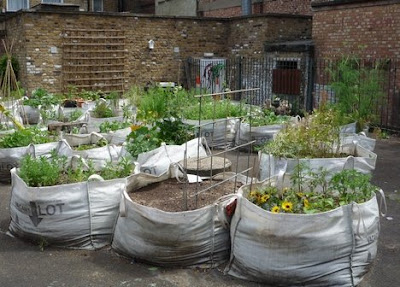Pardon the bad pun, but a bunch of posts that deal with urban agriculture using a variety of containers motivated me to post on the selection and phenomenon. Gardens are one of those things that require some sort of container in which to hold soils, plants, and allow for growth. Typically this container is our limited but mostly expansive terra firma – which provides for countless thousands of acres of production years.
There are cases where growing food can benefit, or by necessity requires, elevated/opportunistic/ephemeral containers to either avoid contamination, occupy spaces temporarily, or allow for visual and agricultural excitement by confronting urban dwellers with – honest to god – veggies growing right in their own city! The following is a range of examples culled from the ether… for your education and enjoyment.
The first, a Foldable Greenhouse via Inhabitat: “Dutch designer Daniel Schipper created the foldable greenhouse for city gardens and rooftop terrariums. Made from recycled plastics, the greenhouse roof folds up flat for easy storage and transience.”
The containerization runs from the mundane…
…to the mobile…
… to the Popeilian…
… to the hyperbolic.
Ok, time for the payoff – of Bag-riculture… A couple of different examples. One from London, via Treehugger and from the group What If… Urban Grow Bags offer an allotment garden of one cubic yard of soil – for whatever you see fit…
:: image via Treehugger
:: image via What If
The second is via Treehugger as well, some Swedish Garbage bags from Gotenburg… courtesy of Topher Delaney.
It seems as if it matters less the container, and more the content – no one more apt to explain this than one of my influential teachers via writings over the years…Wendell Berry, from “A Native Hill” in The Art of the Commonplace: The Agrarian Essays of Wendell Berry, via Archidose:
“Until we understand what the land is, we are at odds with everything we touch. And to come to that understanding it is necessary, even now, to leave the regions of our conquest — the cleared fields, the towns and cities, the highways — and re-enter the woods. For only there can a man encounter the silence and the darkness of his own absence. Only in this silence and darkness can he recover the sense of the world’s longevity, of its ability to thrive without him, of his inferiority to it and his dependence on it. Perhaps then, having heard that silence and seen that darkness, he will grow humble before the place and begin to take it in — to learn from it what it is. As its sounds come into his hearing, and its lights and colors come into his vision, and its odors come into his nostrils, then he may come into its presence as he never has before, and he will arrive in his place and will want to remain. His life will grow out of the ground like the other lives of the place, and take its place among them. He will be with them– neither ignorant of them, nor indifferent to them, nor against them — and so at last he will grow to be native-born. That is, he must reenter the silence and the darkness, and be born again.”











